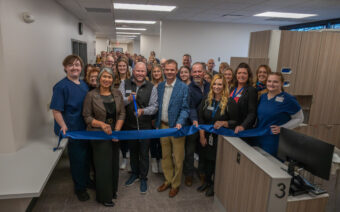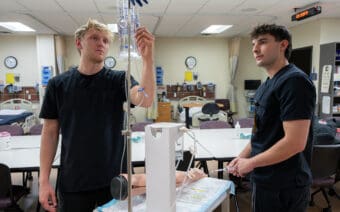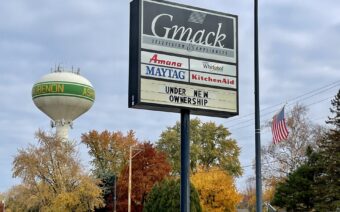
June 17, 2024
CLEVELAND – For higher education institutions across the Badger State and beyond, it’s crucial to stay up to date on workforce trends and match their curriculum to what is most needed from employers.
This, Lakeshore Technical College (Lakeshore) President Paul Carlsen said, is why the technical college is working toward an accredited dental hygiene associate degree program.
And, with the help of a $1.26 million grant from the state’s Joint Finance Committee, Carlsen said Lakeshore should see the program come to fruition by fall 2026.
The more than $1.2 million awarded was part of $20 million passed by the state Assembly and Senate – and approved by Gov. Tony Evers – aimed at improving Wisconsin’s oral healthcare workforce.
Not only will the college receive a new program geared toward oral healthcare education – Carlsen said Lakeshore’s current dental assistant program will see improvements as well, such as expanding from six dental chairs to 10.
Dental assistant vs. dental hygiene
Though the two programs have similar names and some overlap, Carlsen said the dental hygiene program will be more intensive.
“When you go into the dentist, and you’re working with a dentist and hygienist, sometimes a person will be in the lab helping both the dentist and hygienist – that’s a dental assistant,” he said. “Not necessarily doing work inside the mouth but helping those who do.”
Through the dental assistant program, Carlsen said students have the opportunity to work in Lakeshore’s dental clinic, where local dentists volunteer their time for students to get hands-on experience.
“That clinic is open to the community for any patients who are BadgerCare or Medicaid eligible,” he said.
In comparison, dental hygiene courses will focus on the science, hygiene radiography, pharmacology and pathology for dentistry.
For real-world context, Carlsen said those courses are for people who clean patients’ teeth, take X-rays and process them – “and all sorts of other important procedures.”

The idea to implement a program like that at Lakeshore, he said, has been “considered in earnest,” and with the grant is now becoming reality.
“We’re a couple of years out (for the program), but it aligns perfectly with the availability of this funding to move our timeline up to start the process of writing the curriculum of the program,” he said.
The need to get the ball rolling, Carlsen said, comes from a “significant demand” for local dental hygienists.
“I’ve been president of this college for seven years, and for all those seven years, our dental community has been asking for the hygiene program, and it’s great to finally offer that and meet our community needs,” he said.
Carlsen said Lakeshore created a survey for local dentists and discovered they anticipated 10% of their dental hygienists or assistants will be retired in the next two years.
“You’re going to have a seismic shift in the workforce,” he said.
Carlsen said there are already more than 160 open dental positions in the Lakeshore service district.
He said Lakeshore also found that, upon graduation, dental hygienists typically start with a salary of around $75,000, locally.
More details
Once the program is operational, Carlsen said it will start out by graduating 10 students annually.
“We do have some capacity there to run multiple cohorts at the same time to grow that cohort as needed,” he said.
On top of the addition of four dental chairs to the already existing six, Carlsen said the college will also be modernizing its X-ray equipment and other tools to make sure everything is up to current standards for both the dental assistant and dental hygiene programs.
While there is a plan in place, he said Lakeshore must have the program accredited before opening enrollment, which is an 18-month process.
“The program has to be fully accredited by the Commission on Dental Accreditation (CODA),” he said. “So what that requires us to do in that process… we have to hire a faculty who will be teaching the classes, then that faculty has to write the entire curriculum from day one to graduation, at which point CODA will review that and give the thumbs up to offer the program.”
Typically, Carlsen said final approval for programs takes about 1-2 months, but since CODA has to approve the program, it takes more time.

“That’s important because to have a dental hygiene program, it has to be accredited,” he said. “If it’s not accredited, you can’t offer the program, and students can’t access federal financial aid for such a program.”
A community effort
In addition to the $1.26 million from the Joint Finance Committee, Carlsen said Lakeshore is currently engaged in a fundraising campaign that has raised more than $2.1 million.
“We’ve had positive results from both our dentists and nine dentist employers who recognize there’s a significant need for dental hygienists, and they want to make sure that need is filled to maintain a high quality of life in our communities,” he said. “We’re excited to have the Joint Finance money and to have folks and employers also chipping in to make this a reality.”
The amount of effort coming from several different ends to start up the program, Carlsen said, shows one of Lakeshore’s strengths is its ability to respond quickly to community needs.
“What this means for our local community and our students, is that those who want to be a dental hygienist don’t have to go to Milwaukee or Green Bay to get their education and come back here to work,” he said. “The folks who are living in our communities will have the opportunity to learn in our communities and then work in those communities.”
To learn more, visit gotoltc.edu.
 Preserving the past while serving the present, future
Preserving the past while serving the present, future Tomahawk motel under new ownership – but the tradition continues
Tomahawk motel under new ownership – but the tradition continues








